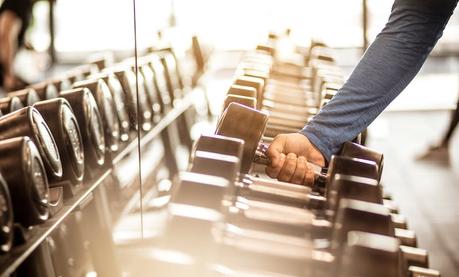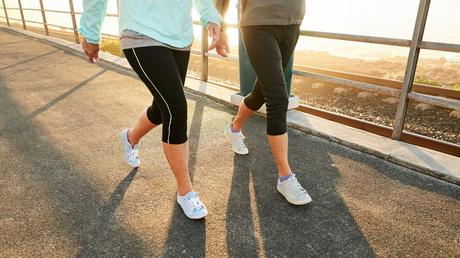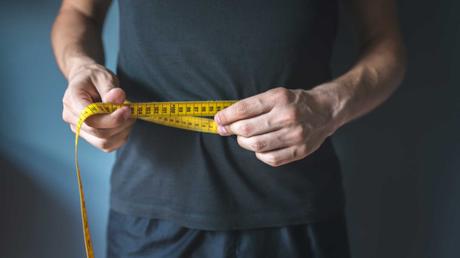Short-term intermittent fasting for fat loss
Time-restricted eating or short-term intermittent fasting, of less than 36 hours, can help with fat-mass loss with minimal to no loss of muscle mass. However, with longer fasting periods, there is a concern about losing muscle mass.
One study shows that six weeks of alternate-day fasting led to a 7% overall weight loss, most of it fat mass.
Another randomized trial reports more significant fat-mass loss with intermittent calorie restriction than with traditional dieting.
And an analysis of eight studies looking at time-restricted eating or alternate-day fasting plus resistance training demonstrates maintenance or even an increase in muscle mass.
Although not all studies agree. For instance, one randomized controlled trial that did not dictate how much or what the subjects ate didn't demonstrate a benefit for lean mass in those doing 16:8 time-restricted eating. One potential lesson is that your diet quality and total caloric intake are still important when engaging in time-restricted eating.
Older studies with longer fasting periods report a negative nitrogen balance - a marker of muscle loss. This suggests that the duration of fasting may play a critical role in your body-composition response.
What should we make of this evidence? Time-restricted eating and short-term intermittent fasting may help reduce calories without significant muscle-mass loss. But longer fasts may lead to muscle-mass loss, and what you eat during your "eating window" may impact your body-composition response. Given the limited amount of research in this field, we need studies that assess the long-term effects of intermittent fasting on body composition.
What to avoid to improve body composition
When looking to improve your body composition, what you don't eat may be just as important as what you do eat. Here are three things to avoid to improve your body composition.
Summary
High-protein diets are most beneficial for adding muscle mass. High-protein, low-carb diets are also beneficial for losing fat mass and improving satiety.
Other dietary approaches that reduce calories, including intermittent fasting, may also improve body composition, but too much calorie restriction for too long may negatively impact muscle mass.
Exercise
In addition to proper nutrition, exercise can be a powerful tool for improving body composition. Here's what science has to say about the best exercises.

Resistance training
Resistance training may be the most impactful intervention to increase lean body mass - including both muscle and bone mass.
Other forms of exercise - such as aerobic exercise like walking and jogging - are helpful for cardiovascular fitness and can improve blood sugar and blood pressure, but resistance training is superior when it comes to building muscle. Resistance training is also beneficial for reducing body fat and visceral fat - that's a powerful combination!
What does resistance training mean? Many people think it means going to the gym and pumping heavy iron alongside bodybuilders and muscle-bulging athletes.
That is not the case.
Resistance training means moving your muscles against resistance. That could mean using your body weight as resistance (such as squats or wall pushups), using elastic bands as resistance, or using two-pound weights.
As long as you continue to challenge your muscles, they will maintain or grow. Unlike fat loss, which happens across your whole body, building muscle with resistance training has a very targeted effect. If you only work your arms, only your arms will gain muscle and your legs will remain unaffected.
Here are some helpful tips to get started with resistance training:
Other exercises

Cardio training may not be the best for building muscle, but it can be helpful for burning fat. The downside to cardio is that you generally need to commit to longer workouts to see substantial benefits. But if you have the time and commitment, you should go for it!
The best training program may be a combination of resistance training three days per week with cardio or intervals on three days, with a day off that might include stretching or mobility work.
And remember, both walking and running are considered "weight-bearing exercises" and can improve your lower-body bone mass. Just don't ignore your upper-body strength!
High-intensity interval training is also helpful for fat-mass loss and you can include it as part of your training program. However, some studies suggest HIIT may not be suitable for an initial weight loss plan for those unfamiliar with interval training. Also, make sure you pay attention to injury prevention, starting slow and building the duration and intensity of your exercise routine gradually.
For more details about what exercise regimen is best for you, see our detailed guide on exercise and health.
And to learn more about bone health, see our dedicated guide on low-carb diets and bone health.
How to measure body composition
You can measure your body composition in many different ways - from expensive, complex scans to simple at-home tests requiring nothing more than a tape measure. Here are some of the most common methods and our recommendations for which you may want to consider.
Waist circumference

Perhaps the easiest and least technical way to estimate your body composition is measuring your waist circumference. Since the most important weight to lose is the weight around your middle, known as " belly fat," improving your waist circumference can have a meaningful impact on your health.
Greater abdominal circumference in relation to height (waist-to-height ratio) is predictive of an increased risk of diabetes, hypertension, cardiovascular disease and overall mortality, even in people of normal weight. While this isn't a perfect test, it is very easy to do, does not require a doctor's order, and can give you a good starting point to see if you might have insulin resistance.
To get your waist-to-height ratio, just divide your waist measurement by your height. A waist-to-height ratio less than 0.5 indicates good insulin sensitivity, while a number higher than 0.5 indicates worsening insulin resistance.
You don't even need a tape measure. Just take a piece of string! The length of string around your waist should be, at most, half your height. If your waist is larger than half your height, you likely have insulin resistance.
One of the great strengths of this measurement is that your ethnicity doesn't matter, nor does it matter whether you are male or female, young or old, short or tall, muscular or wiry - a number higher than 0.5 indicates increased risk.
Selfies
Another simple way of tracking your body composition is taking selfies to track your physical appearance. Make sure you take the pictures in the same location, time of day, and zoom. You can track the size of your abdomen and the definition of your muscles.
Even if your weight isn't changing much, if you see your abdomen getting smaller and your muscles getting bigger or more defined, then you are likely improving your body composition.
And, no, you don't need to share your selfies on social media! Just because many like to make their journey public doesn't mean you have to. Feel free to put the pictures in a private file and keep them locked away for only you to see.

Get your personalized meal plan with a FREE 30-day trial!
What's your main health goal?
Dual-energy x-ray absorptiometry (DEXA)
A DEXA scan uses low-dose radiation and accurately detects your amount of lean mass and fat mass, the amount of visceral fat, and the density of your bones. The results are more detailed and accurate than bioimpedance scales, but the scan may be less available and more expensive to obtain.
Given the low-dose radiation involved, most people suggest waiting at least 3-6 months between DEXA scans.
Just be sure that you're getting a DEXA scan that assesses body composition. Most routine DEXA scans are ordered only to look at bone density.
When considering the combination of accuracy and detailed information, a DEXA scan may be the best choice, although cost can be a barrier.
Pros: Most accurate and detailed body composition information
Cons: Not for home use, small radiation dose, cost, and availability
Bioimpedance scales
Bioimpedance scales provide an estimate of fat-free mass and fat mass by using a small electric current to measure the "resistance" of your body tissue. These scales are easy to use, widely available, and relatively inexpensive compared to some of the other methods we discuss.
However, most home scales measure body composition in your lower body only, which limits their utility as much of the concerning fat mass is in the abdomen and trunk. Some have handles you can hold to also measure your upper body, but these are more expensive and usually located only at gyms or personal training centers.
But even these more expensive scales are affected by non-standardization of body position, recent exercise, and hydration status. This means that checking your body composition on one of these scales before and after your workout could yield different results.
Bioimpedance scales are not as accurate as DEXA scans but can be used to track trends over time. For instance, an accurate DEXA may show you to have 30% body fat with much of it centered around your abdomen and trunk, while the bioimpedance scale may say you have 20% body fat, as it misses much of the obesity around your middle. But if your bioimpedance numbers are dropping over time, you can still use that to gauge improvement.
These scales are best for people who want to track changes in daily or weekly measurements, but it may be worth adding a DEXA once a year to follow more accurate, absolute measurements.
Pros: Easy to get for home use
Cons: Less accurate than other measurements
Hydrostatic weight
For this one, you need to get wet.
Here's how it works. First, you weigh yourself on dry land. Then you sit on a scale, submerge yourself underwater and blow out as much air as you can. The result is the difference between your dry weight and your underwater weight, which can help estimate your fat mass and fat-free mass.
This type of measurement can't differentiate between bone, muscle, and water which all make up the fat-free mass. Nor can it tell you where your fat mass is distributed - visceral, abdominal, etc. But it is an easy way to accurately measure your total fat mass - as long as you don't mind getting wet.
Pros: No radiation, quick test, and good test-to-test accuracy
Cons: You have to get wet! Not for home use, and may be difficult to find access to the specialized underwater scale
Air Displacement Plethysmograph (ADP)
Another device rising in popularity is the BOD POD, a type of ADP that measures your body's volume by measuring the amount of air your body displaces when in a specialized measuring chamber.
It provides results similar to hydrostatic weight - it reports fat mass and fat-free mass - but it doesn't give as much detail as a DEXA.
Also, if you are claustrophobic, a BOD POD may not be the right test for you as you have to spend several minutes in an enclosed chamber (although there is a window to see out of which does help some with mild claustrophobia).
Pros: No radiation, quick test, good test-to-test accuracy
Cons: Not for home use, may be limited availability, cost, and difficult for those with claustrophobia
Others
Other body composition tests tend to not be as accurate or practical. For instance, measuring skin folds with manual calipers rely on general equations that may be less accurate than other measurements and have significant test-to-test variability.
Other imaging studies, like MRIs or CTs, are expensive and have very limited availability. They are mostly used for research purposes and are impractical and less available for the general public.
Summary
Easiest: Waist circumference
Most accurate: DEXA
Best for regular home use: Bioimpedance scales
Best of the rest: Hydrostatic weight and BOD POD if they are easily available
The best way to improve your body composition
Improving body composition includes decreasing fat mass and increasing lean body mass - muscle and bone mass.
Sustainable calorie reduction has the strongest evidence for fat-mass loss.
A combination of a low-carb, high-protein diet with resistance training may be the most effective for sustainably losing fat mass and maintaining muscle mass. Adding cardio or HIIT exercise can further help with losing fat mass.
Resistance training and higher protein diets (around 1.6 grams per kilo of ideal body weight per day) have the best evidence supporting their role in improving muscle mass.
Now you should have all the information needed to get started improving your body composition today!
Start your FREE 30-day trial!
Get instant access to healthy low-carb and keto meal plans, fast and easy recipes, weight loss advice from medical experts, and so much more. A healthier life starts now with your free trial!
Start FREE trial!

